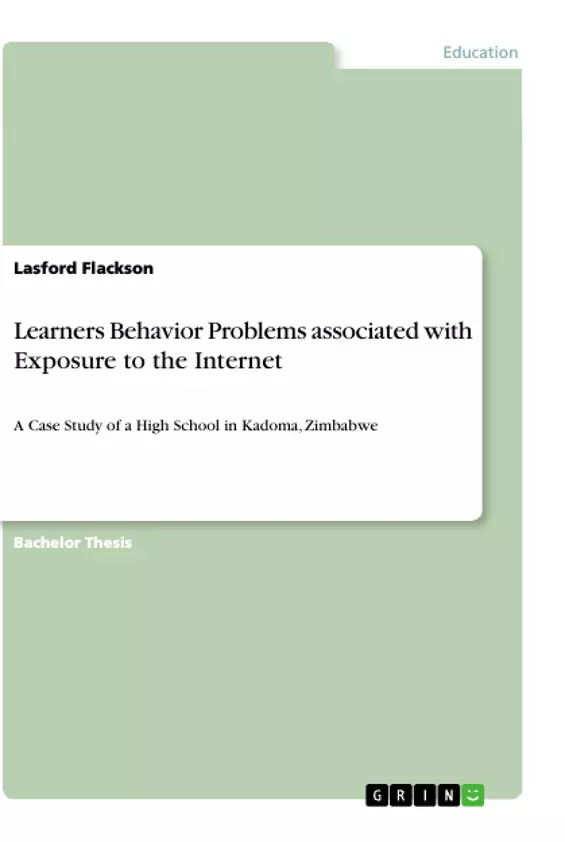The goal of this research is to investigate and analyze learner behavior problems associated with exposure to the internet. The focus area of the research is XY high school located in Kadoma. XY High School is an urban school and most learners have access to electronic gadgets that allow them to access the internet. The researcher has observed that learners have developed some behavioral problems which can be traced to their accessing of internet as some of the behaviors are imminent of cyber cultures. The target population involved a total number of 70 learners derived from both advanced and ordinary level Classes. The School at the time of research had 62 teachers of which only 15 Teachers are involved in the study. Teachers in discipline and counseling department were sampled because they were custodians of behavior and often met students who had behavior issues. They also kept records on which student they had punished and why. Senior Masters and Senior Ladies are the ones who are mainly involved in the counseling of learners along with the disciplinary committee. The disciplinary committee consists of 5 teachers. Basing on the findings of the study, it was recommended that the school administration and teachers in charge of guidance and counseling departments need to inform students about the harmful effects of the internet and excessive use of electronic gadgets.
Inhaltsverzeichnis (Table of Contents)
- Dedication
- Acknowledgements
- Abstract
- Table of contents
- List of figures
- List of appendices
- CHAPTER 1
- RESEARCH TOPIC: LEARNER BEHAVIOR PROBLEMS ASSOCIATED WITH EXPOSURE TO THE INTERNET: A CASE STUDY OF XY HIGH SCHOOL IN KADOMA, ZIMBABWE
- 1.0. INTRODUCTION
- 1.1 BACKGROUND OF THE STUDY
- 1.2 STATEMENT OF THE PROBLEM
- 1.3 ASSUMPTIONS OF THE STUDY
- 1.4RESEARCH AIMS
- 1.5RESEARCH OBJECTIVES
- 1.6RESEARCH QUESTIONS
- 1.7SIGNIFICANCE OF THE STUDY
- 1.8DELIMITATION OF THE STUDY
- 1.9LIMITATION OF THE STUDY
- 1.10DEFINITION OF KEY TERMS
- 1.11SUMMARY
- CHAPTER TWO
- REVIEW OF RELATED LITERATURE
- 2.0 INTRODUCTION
- 2.1 TYPES OF MEDIA MOSTLY EXPOSED TO LEARNERS
- 2.2 INTERNET CONTENT EXPOSED TO LEARNERS
- 2.3 BEHAVIORS OBSERVED AMONG LEARNERS DUE TO EXPOSURE TO INTERNET CONTENT
Zielsetzung und Themenschwerpunkte (Objectives and Key Themes)
The research aims to investigate and analyze learner behavior problems associated with exposure to the internet, specifically focusing on XY High School in Kadoma, Zimbabwe. The study observes the potential influence of internet usage and cyber culture on student behavior. This research analyzes student behaviors and their connection to internet exposure, particularly at an urban school where electronic gadgets and internet access are prevalent.
- The impact of internet exposure on learner behavior
- The role of cyber culture in shaping student behaviors
- Identifying and analyzing specific behavioral problems linked to internet use
- Exploring the role of school administration and guidance counselors in addressing internet-related behavior issues
- The effectiveness of interventions to mitigate negative behavioral consequences of internet usage
Zusammenfassung der Kapitel (Chapter Summaries)
Chapter 1 provides an introduction to the research topic, outlining the background, statement of the problem, assumptions, research aims and objectives, research questions, significance of the study, delimitation and limitation of the study, definition of key terms, and a summary of the chapter. Chapter 2 delves into a review of related literature, exploring types of media exposed to learners, internet content exposed to learners, and behaviors observed among learners due to exposure to internet content.
Schlüsselwörter (Keywords)
The research focuses on learner behavior problems, internet exposure, cyber culture, urban education, electronic gadgets, behavioral analysis, and school interventions. The study explores the relationship between internet usage and specific behavioral issues in a school setting, highlighting the role of cyber culture and the need for effective guidance and counseling practices.
- Arbeit zitieren
- Lasford Flackson (Autor:in), 2018, Learners Behavior Problems associated with Exposure to the Internet, München, GRIN Verlag, https://www.grin.com/document/468231



